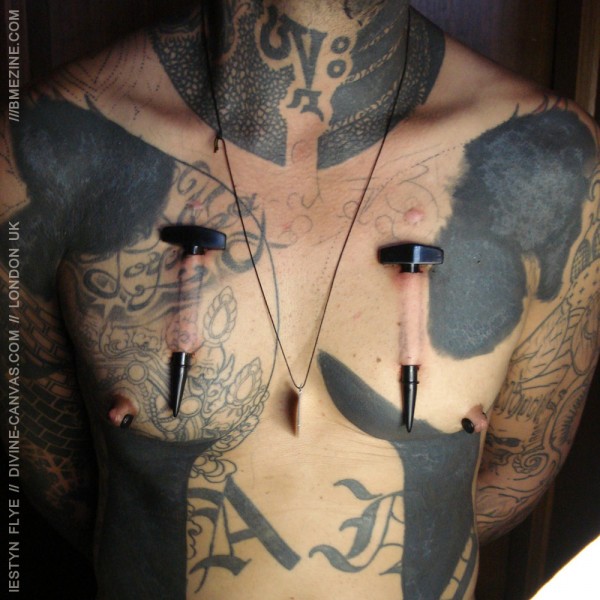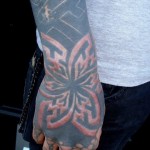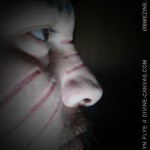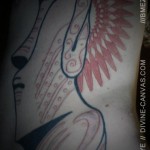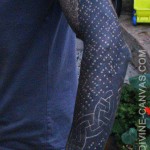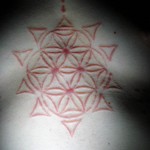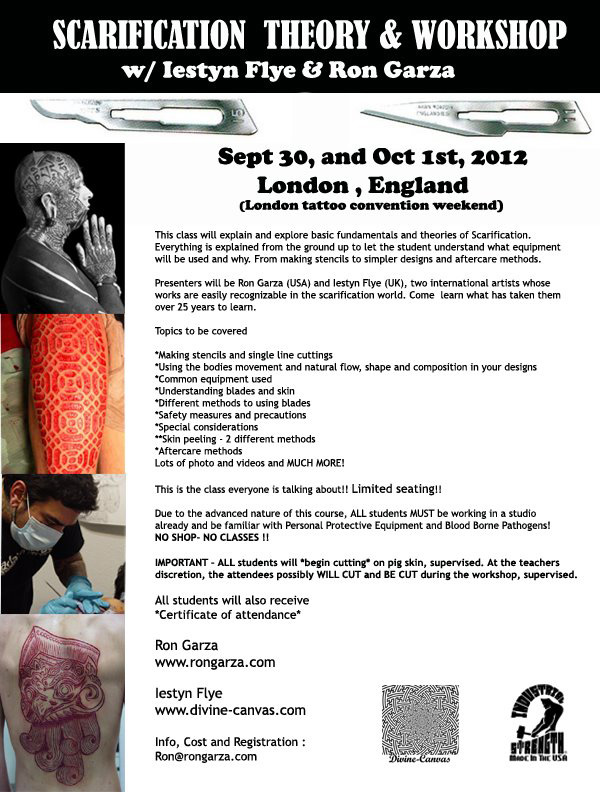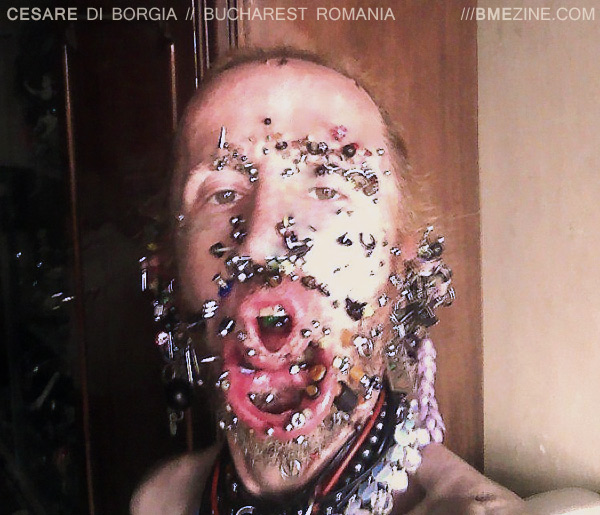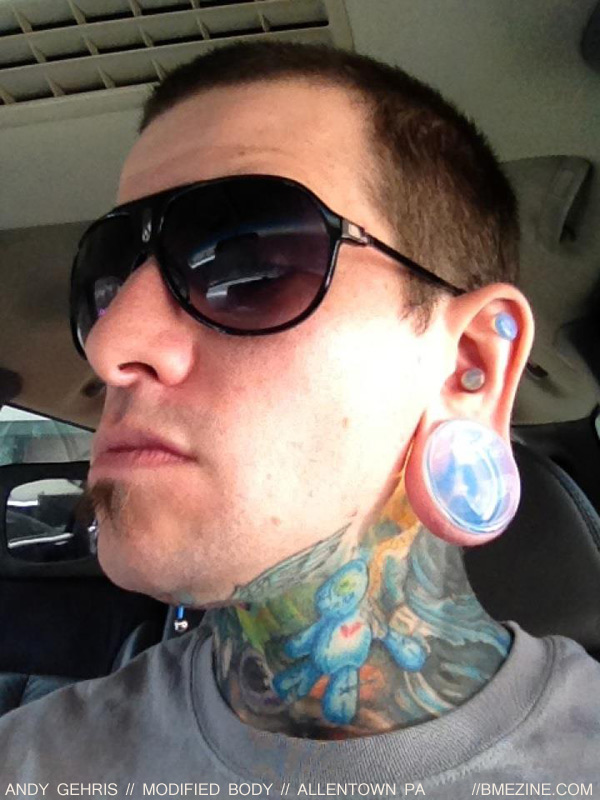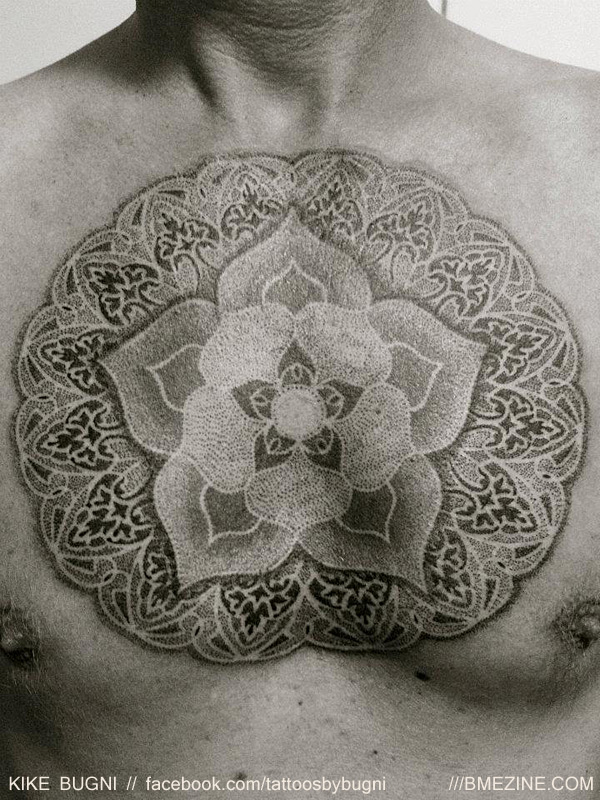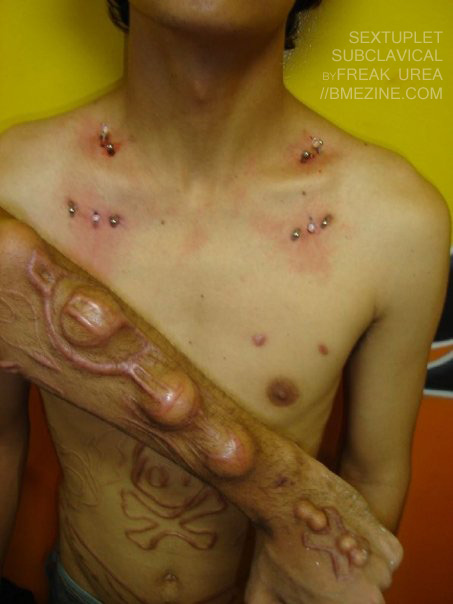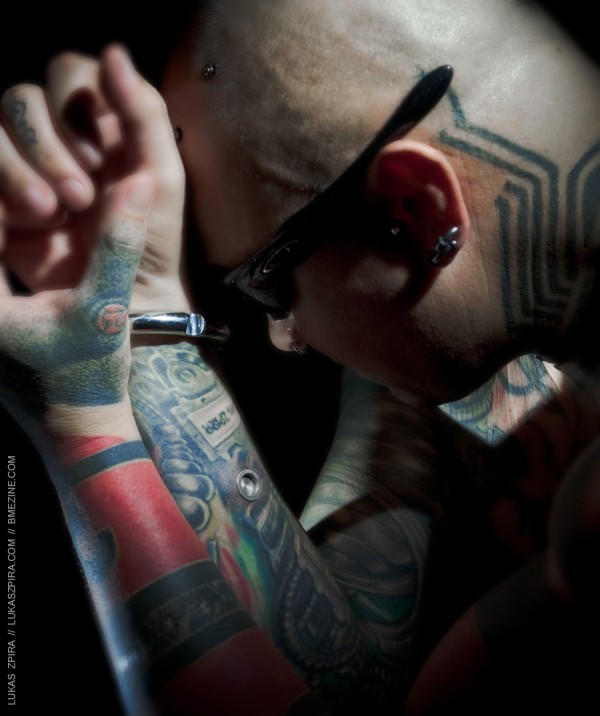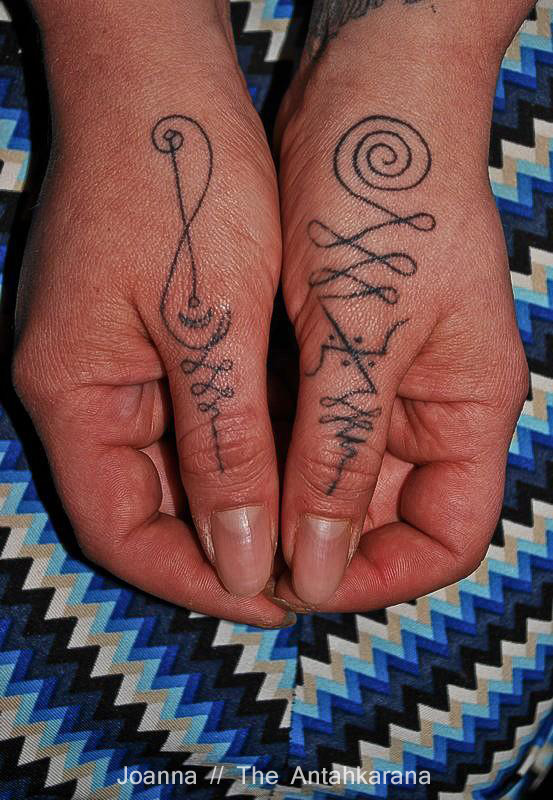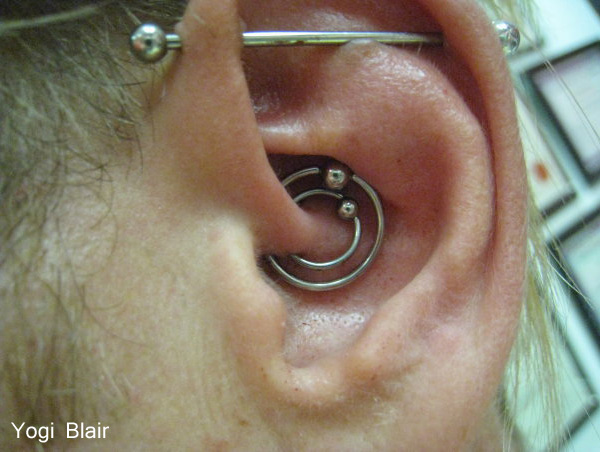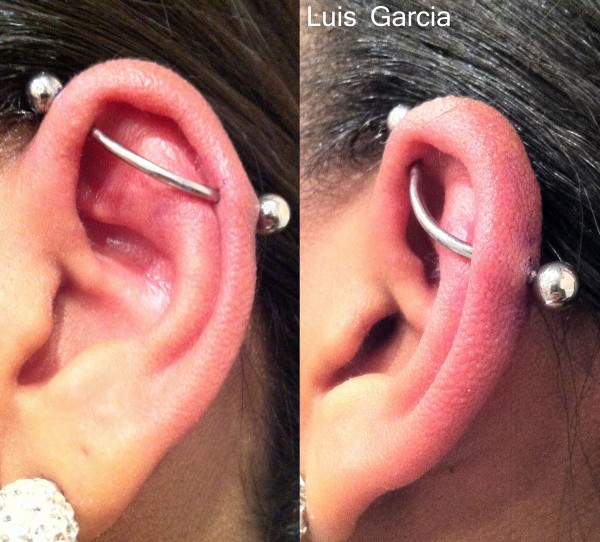One of the first tattoo artists to introduce me — and the larger BME community — to the new French art-style of tattooing was Lionel Fahy of Out of Step Tattoo (http://lioneloutofstep.blogspot.fr/). What you may not know, is that not only is he a brilliant tattoo artist, but he’s also an amazing musician. In this video slideshow of his tattoos, the soundtrack song is also his work, so be sure to listen to this with the sound turned on.
Author Archives: Shannon Larratt
Post navigation
Deep Chest Piercings
Speaking of Iestyn Flye (see the entry below this one for the scarification seminar he’s hosting with Ron Garza), I also wanted to share this amazing set of very British deep chest piercings he did. You may be wondering to yourself how such a thing could heal, since of course if you shrunk the whole thing down to 14ga, this would be about the least advisable way to do a surface piercing. However, once you start talking about this bulk of tissue, the body responds quite differently and rather than trying to spit the material out like a sliver, accepts it as “too large to fight” and sullenly heals around it — albeit in a process that can take a year or more to fully mend (with a certain amount of kicking and screaming by the tissue!).
I have been reading some of the comments on things I’ve posted with great interest. I appreciate the many warm welcomes, but it is interesting to note there are some very conservative voices commenting with knee-jerk reactions to fringe body modification pictures without reading or understanding the associated text. I wonder if that will happen with these as it did with the subclavicles? Please, readers — try and give what I post the benefit of the doubt. If I post something I feel is unsafe, I assure you, I will say so. Yes, I have a high tolerance for the unusual, but I am also not a naive fool that doesn’t have enough experience to know what the body can heal safely and what it can’t. Over twenty years ago, in the 1980s, when I was a kid in highschool, I told my then-girlfriend that I would never get a tongue piercing, and that to do such a thing was an insane risk. That seemed a reasonable thing for me to say at the time, but it sure sounds silly now, doesn’t it? If I’ve learned anything since then, it’s that the body is a remarkably pliable vessel for our sentience, and that it will tolerate being manipulated and sculpted in far more diverse ways than common sense would suggest. Now, there’s nothing wrong with caution — it keeps us alive — but there is something wrong with continuing to have that fear when time and experience show something to be possible. And of course we must remember that aesthetics differ not just between cultures, but between individuals, and one may enjoy pale plainskin, another symmetric perfection, and another a face that looks like it was caught in an explosion at a body jewelry factory. To me, that’s always been a wonderful thing about BME — that it embraces all those flavors.
London Scarification Seminar
I wanted to share with you a flyer on the scarification seminar being hosted by Iestyn Flye and Ron Garza the weekend of the London Tattoo Convention (September 30th and October 1st). This is a hands-on fundamentals and theory class for active practitioners (you must be working at a shop and familiar with blood borne pathogens to sign up) interested in scarification, hosted by two of the top scarification artists in the world. Of course Ron Garza is an old BME favorite, but since Iestyn (of Divine Canvas in the UK) may not be as well known here, I’d like to begin by posting a small sample of his scarification work.
Whether you are a fresh beginner, or whether you’re an experienced artist, I can’t imagine anyone not coming away from this seminar with vastly improved skills to offer their clients. If you’re a scarification artist or a piercer or tattooist interested in getting into this field, and can get to London for this, you won’t regret it. Here’s the flyer itself:
Two mouths are better than one
I’m used to posting dozens of entries a day, which I realize ModBlog isn’t quite used to and since things are now scrolling a page away without many people even knowing that I’m writing anything at all, I think at this point I will call it a day and build up steam as time goes on — and assuming I adjust to doing this (and I’m sure many of you understand how difficult this is for me emotionally), I will probably cross post links or a digest to Facebook, and continue covering the mod community from my vantage point.
In any case, I want to share someone who ranks very high up the list of my favorite mutants, the amazing Cesare Di Borgia, who I know has been posted here before so I hope you’re familiar with him. Not only does he have an incredible chaotic collection of facial piercings — it’s impossible to miss! — and massive stretchings, but not visible in this picture he also has subclavicals and other radical deep piercings including bars through his biceps, which may well be unique. And Cesare is anything if not unique. He is a real gem, a beautiful oddball, and a wonderful man on a personal level as well. It’s guys like Cesare that keep me excited after all this time about body modification. Anyway, the reason I chose to share this photo he posted today is that I love the effect that his drooping plateless lip piercings give, almost as if he has two mouths. It actually takes a moment to even realize exactly what you’re seeing!
I also know that I can judge whether I will like a person by their reaction to Cesare — whether it be open minded or it be fearful or even angry bigotry. He’s not someone that inspires ambivalence. Later days, everyone.
Andy’s Decade-Old True Mandible
Speaking of deep piercings, another classic of that genre is the mandible piercing, also known for a while as the “sprung” piercing, after the first woman to have it done by the late Mick Noland, although that name is all but forgotten these days. Although this piercing doesn’t pass into the inner body like subclavical piercings do, it passes through a remarkably large collection of different kinds of tissue and narrowly evades numerous pieces of anatomy that would rather not be skewered, so it is another piercing that makes many people’s “never do” lists… But again, it also has proven itself a viable and remarkably heal-able piercing on the small handful of people who’ve worn it. Andy Gehris of Modified Body (a part of Art-n-Soul in Allentown, PA) has had his as long as anyone I can think of, with the piercing now being ten years old and counting.
Just to be clear for those that are not familiar with this piercing, it is a bar that passes from below the tongue (inside the mouth) straight down inside the jaw and out the bottom. You can also do a “fake” mandible piercing with a surface piercing or microdermal (or transdermal for more permanence), but this is a “true mandible”. Another slightly clearer photo from earlier this year is after the break.
Dotwork Chest Mandala
It’s amazing how much dotwork — often hand-poked with modern interpretations of traditional methods — and geometric tattooing has exploded in the last two or three years. What was once an aberration, a unique style championed by two or three eccentric tattooists, has become commonplace across Europe, and is now spreading into the Americas. This example of a beautiful chest mandala is by Kike Bugni, working this month between August 6th and 16th in Copenhagen at Baby Lou Tattoo and then in Stockholm from the 22nd to the 28th at Infamous Studio.
Six Deep Clavicle Piercings
You almost certainly recognize him by his immense forearm implants in the foreground of the picture, but this radical piercing set was done by Gerson de Arauju of João Pessoa, Brazil, who you likely know better as FREAK UREA. His client now wears six sub-clavicle piercings, which may be the most installed in anyone (I can think of several people with four). Sub-clavicles are one of those conundrum piercings which common sense tells you should be almost comically suicidal in nature, opening such an easy channel for infection into the inner body… yet they have proven themselves in the small handful of people wearing them (perhaps a few dozen) to be shockingly trouble-free, taking about a year to heal and rarely causing complications in either the long-term or the short-term — unlike transscrotals, which when done in this style (pierced, not sutured), can hospitalize a person with a life-threatening infection within days of getting it.
Now, please don’t read this as me putting on a stamp of “safe” approval because I still consider it near the top of the “risk-level” chart — but, let eyelid piercing and eyeball tattooing and a few other things that common sense says should be high-risk catastrophes, the test of time so far is showing this piercing to be more of a kitten than a lion. And I have to admit that this is to my great surprise.
And as a general PS — I always tell people to watermark their photos because of how many people steal pictures and repost them, or worse, claim them as their own work. I’ve always enjoyed how Gerson “watermarks” a picture by tossing his very unique arm into the shot.
Titanium Skin
I wanted to share with you an amazing concept piece from Lukas Zpira that’s actually from way back in 2007, but because it’s been in development, he’s kept it largely under wraps. You may remember the new transdermals from Samppa Von Cyborg that I wrote about a little while ago, and you can file this in the “great minds think alike” category, because for some time Lukas has also been working with implants that are anchored with ITAP-style small holes (and as far as I can document is the first person to implant a piece of this particular design), and are also of a rough finish to allow easier integration with the body (in fact, the transdermals that he sells have a similar finish — so I’m happy to see this idea is not limited to a single person). Lukas takes the transdermal concept a big step farther, by using some of those ideas to allow the creation of a titanium skinned “pod”.
Imagine a transdermal implant in reverse. So instead of the implant coming up and out of the skin, it creates a hole or indent in the skin, which is backed with titanium plate. Here is a closeup of what it looks like in the body:
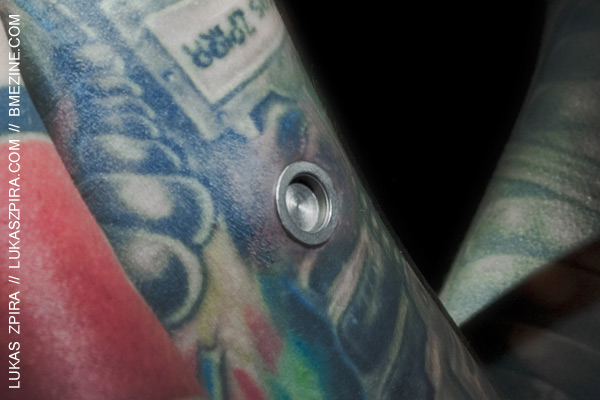
And here is what the jewelry looks like:
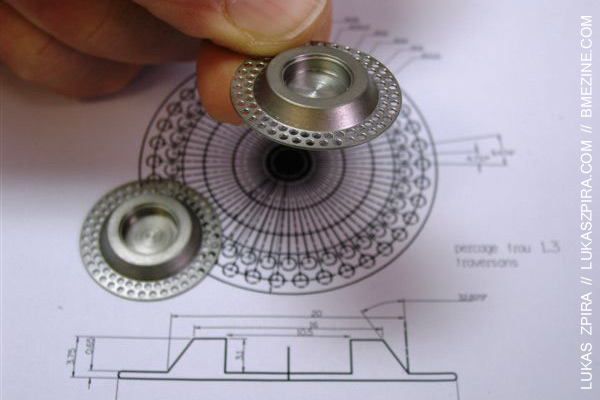
Quite remarkable, isn’t it? Lukas Zpira installed that piece back in 2008 and wore it for the next eight months before taking it out to examine the healing tissue and to make way for the next generation — he’s planning larger pieces capable of holding electronics for example, although the project has been stalled by some of his other artistic work of late which I’ll post about another time. Below you can see a larger photo of the prototype in Lukas’s arm. I absolutely love the “inset” look of these pod implants, and am quite eagerly awaiting to see future improvements and variations on the design.
If you’re interested in having something like this done, I can’t tell you that it’s ready for public consumption, but Lukas can be reached c/o lukaszpira.com
Joanna’s Thumbs
The importance of choosing the right jewelry
Industrials are of course a “fan favorite”, and a lot of clients come in wanting them because they seem quite “extreme” to the beginner in the piercing world, but are still fairly safe and accessible. However, not everyone has the ear for it — sometimes this is because the fold of the helix is not pronounced enough, and sometimes, as in the case of the ears in this post, it is because the ear is too curved, not allowing for a straight line to be drawn between the potential start and finish of the piercing. Now there are three ways to deal with this — first, you could not do the piercing. Second, you could not worry about it and go ahead and do it anyway. That’s what happened in the case of the piercer who worked on Yogi Blair’s ear here, and as you can see, the industrial ended up rather grotesquely sinking into his flesh over time. Not pleasant. He has since removed the industrial.
Sure is a gorgeous double daith though — the person who did that has some skills!!! The third option, which is the one that master piercer Luis Garcia chose for his client, is to use jewelry that curves around the ear’s anatomy. You know, I titled this entry “the importance of choosing the right jewelry”, but now that I think about it, I should have written, “the importance of choosing the right piercer”.
